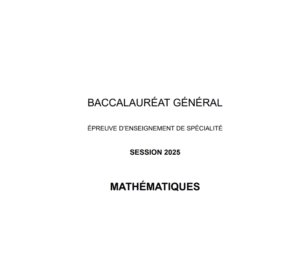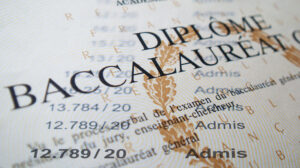Jeudi 12 mai 2022 a marqué pour plus de 500 000 élèves de terminale le deuxième jour des épreuves de spécialité du baccalauréat 2022. Lors de cette session, vous avez été très nombreux à composer en LLCER (langues, littératures, civilisations étrangères et régionales) anglais. Nous partageons donc avec toi une proposition de corrigé pour cette épreuve de spécialité LLCER anglais.
Comment se passe l’épreuve de spécialité LLCER anglais ?
L’épreuve de spécialité LLCER anglais dure 4 heures. Nous te conseillons de bien faire attention à ton chrono. 4 heures ça peut te paraître long, mais quand tu as la tête dans ta copie, les heures passent très vite.
Lors de cette épreuve, tu devras rendre la synthèse d’un dossier documentaire. Tu auras 3 ou 4 questions pour t’aiguiller et tu devras ensuite fournir des réponses en environ 500 mots. Tu devras également réaliser une traduction d’un passage du texte d’environ 600 signes (espaces compris).
À l’issue de cette épreuve, tu obtiendras une note sur 20 points.
À savoir : tu as droit à un dictionnaire unilingue pour cette épreuve.
Le sujet de l’épreuve de spécialité LLCER anglais du bac 2022
Le corrigé des sujets de LLCER anglais du bac 2022
Corrigé du sujet 1 de LLCER anglais du bac 2022
Synthèse
Le premier sujet te permettait de t’interroger sur l’impact de la culture populaire sur la société. Comme le soulignent les trois documents, Elvis Presley est apparu comme un changement surprenant. Dans ses vêtements singuliers, il était la représentation d’un avenir nouveau et futuriste. Tu peux donc développer ce point dans une première partie. Ensuite, tu peux également t’intéresser aux relations sociales qui sont évoquées dans les documents. A l’époque d’Elvis, l’idéal de la « famille nucléaire » était en effet mis en avant comme le soulignent les documents du corpus. Enfin, la manière dont la société consomme la culture est impactée par ces changements : la culture visuelle prend ainsi le pas sur la culture écrite, comme l’expliquent les documents étudiés. Tu pouvais donc choisir ces trois axes d’analyse pour rédiger ta synthèse.
Voici une proposition de corrigé :
Elvis Presley is now considered as the father of Rock’n’Roll, but more than changing the way music was perceived in society, he contributed to change the way people acted in society, as suggested by the three documents under study. Document A is an autobiography which gives a glimpse of how another musician, namely Elton John, perceived Elvis while document B, another autobiography by Bruce Springsteen gives more information about the atmosphere of the period. Finally, document C reveals how iconized Elvis was, but more than being an icon, what was his real impact on society?
Popular culture is associated with light and renewal in the three documents. Document A reads that life was “grim” (l. 24) before Elvis, while document B “there was a great darkness upon the Earth” (l. 1). The surprising dimension of the actors of popular culture is equally underlined in the three documents: in document B, Elvis is described as “unbelievable” (l. 30) while in document A, the author writes that “he came from another planet” (l. 16). This defamiliarizing dimension of popular culture is also thrown into relief by the superimposition of the two bodies in the last document. Everything is as if society was never going to be what it was: popular culture indeed seems to be a step towards the future, as suggested by the futuristic aspect of Andy Warhol’s picture. Similarly, in document B, the word “new” is repeated several times, suggesting a divide between the past and the present. This futuristic dimension is also grounded in the sartorial style of Elvis (“Everything about him looked extraordinary: his clothes, his hair, even the way he was standing” document A, l.7), as it inspired “a new way […] of combing your hair” (document B, l. 7) for instance. Popular culture thus transforms social tastes.
A second aspect to be analyzed in the set of documents is the treatment of social relationships. Documents A and B explicitly enhance family relationships as Bruce Springsteen evokes “parents” (l. 13) while Elton John refers to his “mum” (l. 1), this aspect is less obvious in document C, even if this duplicated Elvis might be understood as the representation of fraternal bonds, notably between twins. Therefore, the three document seem to indicate that popular culture is a way of strengthening family bonds at a time when the stereotype of the “nuclear family” influenced social evolutions. Finally, the three documents also stress the importance of visual images, as if popular culture had transformed the way society had access to culture : in document A, the author admits that he does not read (“I hadn’t even bothered to read the accompanying article” l. 11) while in document B Bruce Springsteen evokes “a new way of seeing” (l. 6), as if the socipc (or visual) dimension of culture had supplanted everything else. This hypothesis is confirmed by document C, a picture devoid of any text.
All in all, Rock’n’Roll and popular culture in general contribute to the transformation of people’s perception of time : popular culture is deeply associated with the future, which brings about new sartorial habits and tastes among society. Moreover, it impacts social relationships and conveys new ways of consuming culture. Yet, one might note that the set of documents was specifically on Rock’n’Roll and that other types of popular culture have different effects: if we think about theatres, they did not always reinforce social relationships as minstrel shows rather racially divided society.
Traduction
Le temps de certains verbes pouvait poser problème. Il fallait ainsi bien maitriser le plus-que-parfait pour réussir cette traduction. Il fallait aussi essayer de rester idiomatique en français.
Proposition de corrigé :
Le weekend précédent, j’étais en train de parcourir les magazines en attendant mon tour chez le coiffeur du coin, lorsqu’une photo arborant l’homme le plus loufoque que j’avais jamais vu attira mon attention. Tout, chez lui, sortait de l’ordinaire : son style vestimentaire, sa coiffure et même sa posture. Comparé aux passants que l’on pouvait voir depuis la vitrine du salon situé dans cette banlieue du nord-ouest de Londres, Pinner, il avait un peu l’air d’un petit homme vert avec des antennes lumineuses lui sortant du front.
Corrigé du sujet 2 de LLCER anglais du bac 2022
Synthèse
Le sujet 2 te permettait de t’interroger sur le rôle de la géographie, notamment des routes dans la culture américaine. Les Américains ont en effet toujours été extrêmement attachés à leur territoire, comme en témoignent les trois documents. Premièrement, les trois documents lient la route à des périodes historiques, montrant comme la topographie est un élément important de l’histoire américaine. En outre, tu peux remarquer que la route est en quelque sorte mystique dans les trois documents, comme si, tout comme le passé, elle était sacralisée. Elle est présentée comme un entre-deux, une limite entre le passé et l’avenir, entre le réel et le surnaturel. Tu pouvais donc utiliser ces idées pour rédiger ta synthèse.
Voici une proposition de corrigé :
The American geography has always been a topic of fascination in novels and movies, as suggested by the novel On the Road by Kerouac (document B) or Dorothea Lange’s pictures (document C). In 2013, The Guardian came back on this attachment to the road, as illustrated by the article constituted by document A. So how to account for this strong bond between American culture and roads?
The paratext of document C clearly indicates how roads are related to important historical periods such as the Great Depression. Similarly, document A starts by showing how roads and American history are connected. The journalist indeed provides the readers with a chronology of events related to topography : “From the first “road trips” of the pioneers lighting out for the west, to the California gold rush, to the dust bowl refugees of the Great Depression chasing the sun across the continent, sustaining themselves on movement, banking on hope, America has counted on the rewards of the road.” Indeed, populations have been able to migrate within the United States thanks to roads, and one might add the Great Migration to the journalist’s list. Kerouac’s character also indirectly refers to the past when comparing himself with a “ghost” (l. 23).
This comparison with a ghost reveals another dimension of the road: it is a mystic element of the American geography. The road indeed seems to be sacralized in the three documents, the mention of the “Promised Land” (l. 4) in document B shows how important the road is and how hopeful the character is while document A also refers to “hope” (l. 23). More importantly, in the background of document C, one might see a cross, which can be interpreted as a reference to a Christin cross. These elements thus suggest that the road is a sacralized place in American culture.
Yet, it is hard to say if the road is more related to mysticism or to pragmaticism given its liminal status. Roads represent in-betweenness as suggested in the documents. For instance, in document C, the man is standing in the middle of the road, no destination is suggested. The road is indeed a transitive space of liminality as explicated in document B : “I was halfway across America, at the dividing line between the East of my youth and the West of my future” (l. 23). In document A, in-betweenness is also hinted at while the journalist highlights that the road is a place where one takes decisions : “You decide when and where, left or right, turn back or forge ahead.”
Therefore, the road holds an important place in American culture: it is a connective element, a place of encounter between populations, the past, the future, as well as imagination and reality. This is thus no surprise that American culture is full of numerous novels and literary works involving the road such as Edith Wharton’s writings or William Carlos Williams’s poems.
Traduction
Il fallait surtout faire attention à la conjugaison des verbes au passé simple pour réussir cette traduction.
Proposition de corrigé :
Je levai les yeux vers le plafond fissuré, tout en haut, et, pendant environ 15 secondes qui me parurent étranges, je ne savais plus qui j’étais. Ce n’est pas que j’avais pas peur mais c’est simplement que j’étais quelqu’un d’autre, un étranger, et que tout, dans la vie, me hantait, que j’avais mené la vie d’un fantôme. J’avais parcouru la moitié des États-Unis et me trouvais à la frontière qui séparait l’est de ma jeunesse et l’ouest de mon avenir, et c’est peut-être la raison pour laquelle cela s’est produit là-bas et à ce moment-là, cet étrange après-midi rouge.











